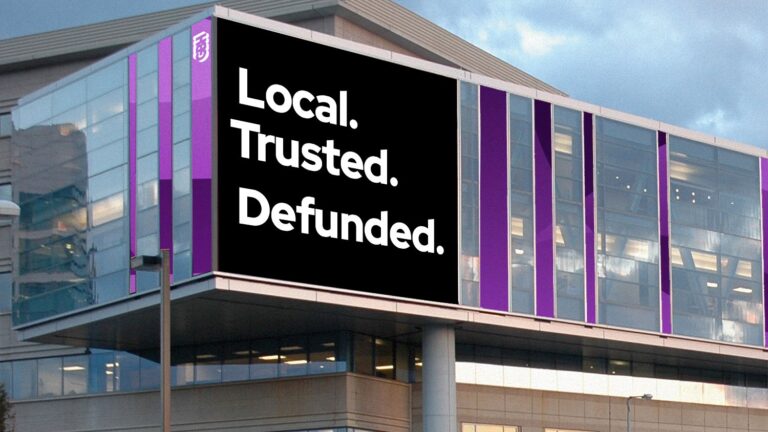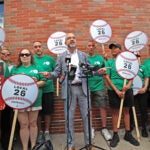A Brief (and Stormy) History of The CITGO Sign

Nothing says “Boston’’ quite like the iconic CITGO sign.
The white sign, which today features a massive flashing red triangle, has loomed over 660 Beacon Street in Kenmore Square since 1940 when it was installed at a Cities Service divisional office.
The blinking beauty has only featured the recognizable CITGO trimark since 1965 when it got a facelift, however.
Since then, it has become closely tied to baseball, as it was seen in the background on Red Sox television broadcasts, and it has also stood above the Boston Marathon route.It has had music written about it, and it was the subject of a 1968 film that took honors at the Yale Film Festival.
The 60’x 60’ behemoth Bostonians now know and love replaced the older green and white Cities Service sign in 1965, when Cities Services changed its name to CITGO and incorporated the triangular logo city dwellers will vehemently defend as “not an eyesore.’’
The sign hasn’t been without its critics, however.

The original Cities Services sign is shown in a 1946 Boston Globe illustration.
During the energy crisis of the ‘70s, some saw the sign as an energy-sucking waste. During the oil crisis of 1973, it was shut off. And after 1974, the sign was no longer lit all night, but instead began operating from 8 p.m. to midnight.
Public debate grew as the sign became lit for fewer hours. The sign was even the subject of a 1976 Boston Globe piece entitled ‘Misty over the CITGO sign,’ in which readers voiced their opinions on the huge blinking square. One called it “Boston’s very own ‘North Star,’ while another called it an eyesore. A third, a former BU student, reminisced that those living in Myles Standish Hall, who had a complete view of it, “had the inner peace of knowing that they could always relax, get stoned, and watch The Sign all night.’’According to The Globe, On May 23, 1979, Gov. Edward J. King put forward an energy plan that called for large, extravagantly lighted advertisements to be turned off to conserve electricity. The plan stated that “All decorative, showcase and ornamental advertising or otherwise nonessential advertising, will be extinguished between 7 p.m. and 7 a.m.’’
On Sept. 4, 1979, the state energy office asked the owners of the sign, Brink Sign Company, “to turn it off as a symbol of the state’s effort to reduce energy waste,’’ according to the Boston Globe.
There was an instant outcry.
“Symbol is the right word,’’ commented The Globe’s Robert Campbell in a 1980 piece on efforts to re-light the sign. “Neon is a cheap light source. Saving the CITGO sign’s cost of about $60 a week isn’t going to panic OPEC.’’
The CITGO sign wasn’t the only casualty of these energy-saving measures: the White Fuel sign, long serving as the CITGO sign’s bright Kenmore Square partner, was taken down in the spirit of energy conservation, having been comprised of incandescent bulbs that made it even more pricey to run than the CITGO sign.
According to Martin Foley of Foley Electric, the so-called “Keeper of the Sign ’’ (he’s been taking care of it since 1965), the four-year period during which the sign was turned off was when Bostonians’ love for it first became apparent.
“They shut it down for about four years because of the energy crisis, and CITGO was going to take it down,’’ he said in a 2010 interview with CNBC. “That’s when people got upset and it became a landmark.’’
CITGO planned to tear the sign down in 1982, but it was given a rescue when The Globe reportedthat the Boston Landmarks Commission announced it would consider designating it as a landmark. The reprieve was truly last minute—workers had already begun hauling equipment to the roof to dismantle the huge advertisement, and were stopped by the commission’s cease and desist order.
On August 10, 1983, just before 9:30 p.m., the sign was re-lit. CITGO had agreed to spend $450,000 to keep the sign maintained and shining bright for three years. According to a Globe article published the next day, “Long searchlight beams swept across the face of the sign, and hundreds of heads tilted upward to watch … Later, three shades of red, a white background and blue letters were blinking in rhythm, speakers mounted on a platform blasted “You Light up My Life,’’ and the crowd drifted from the square.’’

The sign during its relighting ceremony in 1983.
A 2004 renovation gave the sign yet another facelift, according to a CITGO press release. The side of the sign that faces Fenway was kept lit until the end of baseball season while the other side was worked on–the renovation was during the Red Sox’ triumphant World Series run, and it just wouldn’t have been right for it to have been shut off completely.
LEDs Magazine reported the following year that all of the original neon lighting had been replaced by 8,000 feet of LEDs, mainly to make maintenance easier. The sign then became quieter. At least one local told Boston.com that he or she missed the loud buzzing sound the sign’s old neon tubes made.
In 2006, the sign was engulfed in yet another political mess, this one on an international scale. Venezuelan president Hugo Chavez called then-US president Bush “the devil,’’ and City Councilor Jerry McDermott wanted to scrap the sign in retaliationbecause the CITGO company was a subsidiary of Venezuela’s state-controlled oil company. Of course, Mayor Menino opposed McDermott’s resolutionand it never went anywhere.
Then, the sign caught fire in 2008, causing about $5,000 in damage and leaving a charred mark. Some thought it was a bad omen.

A small fire charred part of the huge Citgo sign near the top of red triangle in Kenmore Square.
Most recently, the sign was renovated in 2010 and was made more environmentally friendly. Foley said the LED lights used six years earlier were no longer being produced, so they were removed. As stated proudly on CITGO’s own website (yes, they have a page dedicated to the sign), “Boston residents watched excitedly as the sign was relit on Sept. 17 during the 7th inning stretch of a Red Sox home game—just in time for baseball playoff season.’’








Conversation
This discussion has ended. Please join elsewhere on Boston.com